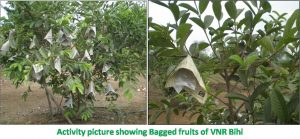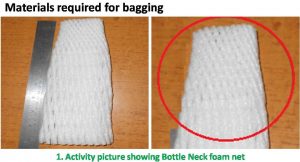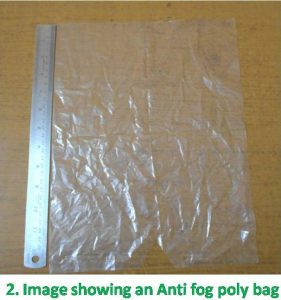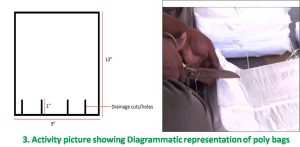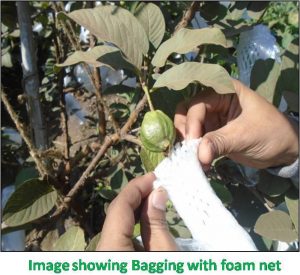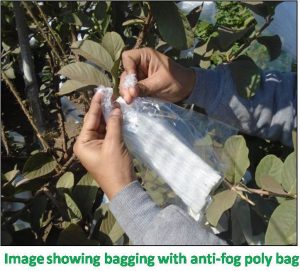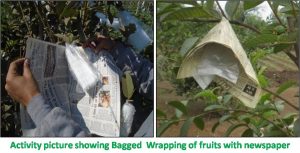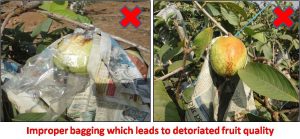What is bagging?
Bagging is a procedure in which fruits are bagged or covered with different materials like foam net, anti-fog polythene bags, and papers respectively, with a view to protect fruits from various biotic and a-biotic stresses.
Materials required for bagging:
- Anti-fog* Polybags (13″ 9″dimension) with proper cuts at its base (1″ length) — 1 piece per fruit
- Newspaper — Half news paper page per fruit
- Foam Net (Bottle neck) — 1 per fruit
- Stapler with pins and cotton thread
* Anti fog poly bags do not hold moisture, making it easy to drain out the moisture transpired by the fruit.
- Advantage of bottle neck foam net is that as the size of fruit increases during its development the foam net do not slide down.
- The anti-fog polythene should have a drainage holes/cuts (one inch cuts on the lower end of it at two-four locations)
- The water thus transpired by the fruit should easily drain out. Else any kind of fungal infection may occur.
Precaution: Use fresh and stain or rust free staples/ pins. Use good quality pins which do not rust easily since rusting will decrease the life of pins and also damages papers and poly-bags.
When to bag VNR Bihi fruits?
It is important to address insects & fungus in the orchard before bagging.
- Spray of following fungicide and insecticides prior to bagging will be beneficial –
- Insecticide – Thiamethoxam – 1ml/litre water
- Fungicide – Thiophanate Methyl – 2gm/litre water.
- Insecticide spray should be done first.
- After 7 – 10 days from Insecticide spray – Do suggested fungicide spray
- Bagging of fruits should be done within 3-5 days from the fungicide spray.
(Quality of suggested molecule stays with the manufacturer & seller of the same, please ensure right quality at the time of purchase, VNPL is not to be held responsible for the same)
After suggested spray (as mentioned above)
- Bagging of fruits should be done when the fruit attains the size of a Ber (Ziziphus mauritiana)/ Jujube OR Lemon. Size of fruit – 1.5 inches diameter & Weight – 40 / 50 gm.
- Only spotless & healthy fruits should be selected for bagging.
- 2 fruits / twig is found best for good size of fruit.
- Fruits in bunches should be avoided for bagging.
How to do bagging?
- Steps involved in bagging of fruit are at first after fruit thinning/ selection of right fruit-
- Cover it with foam net.
- The next step is to cover it up with anti-fog polythene bags followed by newspaper.
Note: The quality of the newspaper should also be accounted. It should be a crease free, new and fresh paper.
Caution: Periodical audit of bagging is necessary due to damages caused by wind, rain or human interference. In the event of damages immediately address/ repair/ or replacement of bagging material is advised to ensure better quality of fruits.
Point to remember
- Take great care while tying the materials (fruit-net, polybag, newspaper)
- One should not damage the peduncle (stalk which joins fruit to the plant) of the fruit in any case while tying. If it is damaged then the passage of food and minerals to the fruit will stop making it fatal for the fruit.
How bagging of fruits can improve quality of fruits in VNR Bihi?
- Bagging (Foam Net) helps to protect the fruits from any mechanical bruises during its growth and development till it reaches consumers hand.
- The use of anti-fog polythene bag protects the fruit from any kind of pest infestation chiefly Fruit fly and also from chemical inputs used during inter-cultural operations.
- Lastly, newspaper helps to develop/maintain uniform colour of the fruit and also safeguards it from direct sunlight/ sunburns.

